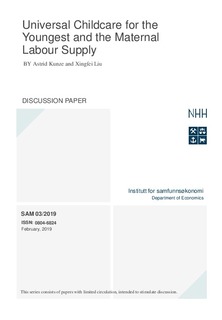| dc.contributor.author | Kunze, Astrid | |
| dc.contributor.author | Liu, Xingfei | |
| dc.date.accessioned | 2019-02-18T12:13:03Z | |
| dc.date.available | 2019-02-18T12:13:03Z | |
| dc.date.issued | 2019-02 | |
| dc.identifier.issn | 0804-6824 | |
| dc.identifier.uri | http://hdl.handle.net/11250/2585920 | |
| dc.description.abstract | In this paper, we investigate whether the expansion of childcare leads to an increase in the female labour supply. We measure female labour supply at both the extensive and intensive margin. For identification, we exploit a nationwide reform that expanded childcare for 1–2 year-olds in Norway. Our results reveal a significant increase in the overall employment of mothers in the target group, but only weak evidence of an increase in contracted hours of work. However, both adjustments are only short term following the reform. When we consider subgroups of mothers more closely, we find substantial heterogeneity in the affected outcomes and the timing of these effects. In particular, when we exclude mothers on job-protected maternity leave and with currently zero hours of work from the target group, we estimate even larger effects on employment and now significant effects on actual hours of work. For mothers with more than one child, we find significant long-term effects of the reform on both employment and hours of work. | nb_NO |
| dc.language.iso | eng | nb_NO |
| dc.publisher | Institutt for samfunnsøkonomi | nb_NO |
| dc.relation.ispartofseries | DP SAM;03/2019 | |
| dc.subject | Childcare, female labour supply, contracted hours, actual hours, causal effects. | nb_NO |
| dc.title | Universal Childcare for the Youngest and the Maternal Labour Supply | nb_NO |
| dc.type | Working paper | nb_NO |
| dc.subject.nsi | Samfunnsvitenskap | nb_NO |
| dc.source.pagenumber | 45 | nb_NO |
